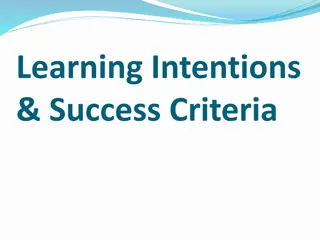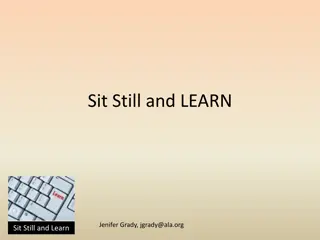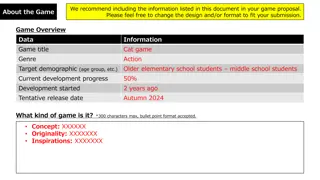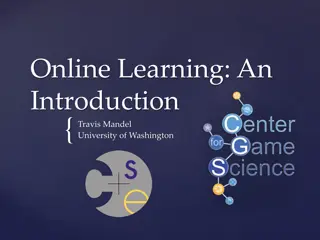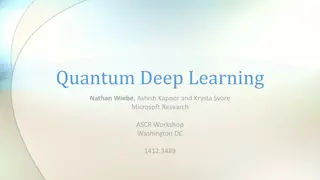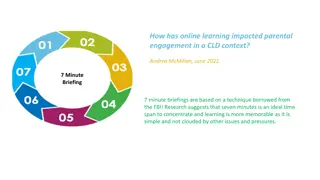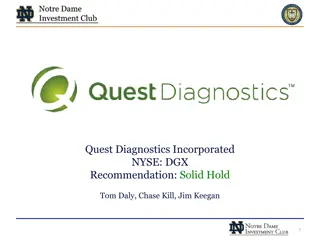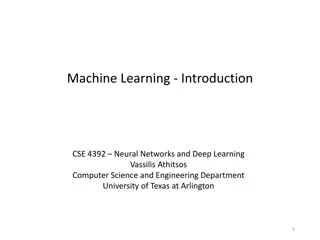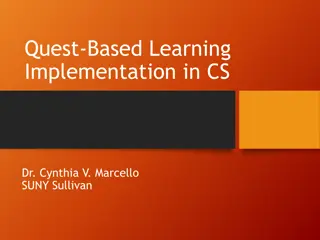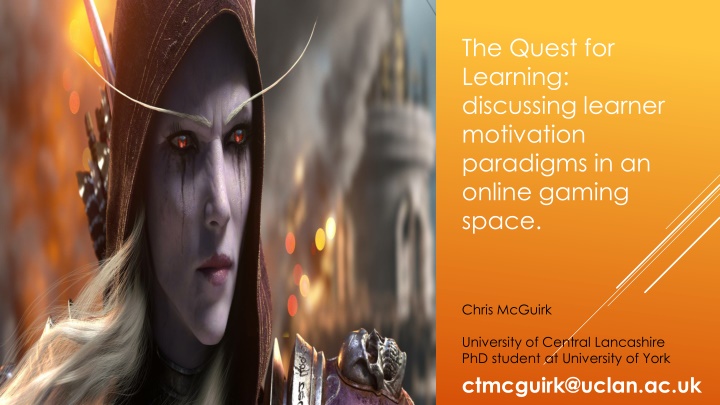
Motivation Paradigms in Online Gaming Spaces
Explore the intricacies of learner motivation paradigms within online gaming environments, considering factors such as serious gaming, extrinsic motivation, and key affordances for educational purposes. Discover the impact of integrating gameplay with language learning and the issues that arise from this working paradigm.
Uploaded on | 1 Views
Download Presentation

Please find below an Image/Link to download the presentation.
The content on the website is provided AS IS for your information and personal use only. It may not be sold, licensed, or shared on other websites without obtaining consent from the author. If you encounter any issues during the download, it is possible that the publisher has removed the file from their server.
You are allowed to download the files provided on this website for personal or commercial use, subject to the condition that they are used lawfully. All files are the property of their respective owners.
The content on the website is provided AS IS for your information and personal use only. It may not be sold, licensed, or shared on other websites without obtaining consent from the author.
E N D
Presentation Transcript
The Quest for Learning: discussing learner motivation paradigms in an online gaming space. Chris McGuirk University of Central Lancashire PhD student at University of York ctmcguirk@uclan.ac.uk
Michael and Chen (2005) games that are being used for an educational purpose. DEFINITION OF A SERIOUS GAME
Playing games online = Candy Crush, Farmville, Angry Birds, etc. Gaming = Serious competitive hobby, usually involving consoles and games with online battles/tournaments/ team exercises DISTINCTION BETWEEN PLAYING GAMES AND GAMING
FPS First person shooters, e.g., CoD, Halo, which have a multiplayer component. MMORPGs (for instance, World of Warcaft, Everquest) RTS (E.g., Starcraft) Minecraft (for instance, the GUINEVERE Project) Augmented realities (e.g., Pok mon Go) EXAMPLES OF GAMES USED IN A MORE SERIOUS WAY
Substantial positive reinforcement rewards, levelling up, new weapons, etc. (see Skinner, 2016; Glover, 2013) Synchronicity (Elverdam and Aarseth, 2007) Translanguaging (see Choudhury, 2017) Communicative drive (Dickey, 2007) KEY AFFORDANCES OF ONLINE VIDEO GAMES FOR SG PURPOSES
Extrinsic motivation. Lots of it. (Glover, 2013) Positive praise, negative reinforcement (Skinner, 2016) Law of Effect (Thorndike, 1898) Instrumental motivation (Gardner and Mcintyre, 1991) WHAT MOTIVATES STUDENTS TO PARTICIPATE IN SG?
Key ideal learner self theories (D rnyei, 2009; Kramsch, 2009)infer that integration is a key motivating factor for gamers. Learners possibly motivated more by the game. Any integration or language learning may actually be implicit. ISSUES WITH THAT WORKING PARADIGM
Scale of motivation going from intrinsic to extrinsic A rebellious self Relatedness, feelings of competence, reduced performance anxiety Even fits if it is assumed that synchronicity is a motivating affordance RYAN & DECI (2000A.; 2000B.): SELF-DETERMINATION THEORY
TBC, but initial thoughts suggest: Learners in an SG environment appear to align language learning with targets that exist within the game. Synchronicity (as opposed to the asynchronicity of CMC), may lead to reduced performance anxiety, a greater level of telecollaboration and a stronger sense of relatedness as teams bond within the game. Intrinsic motivation, initially, may be driven by the game, but might later be about learning the language, as a way of enhancing performance in the gaming space. POSSIBLE HUNCHES
What motivates learners to participate in an online gaming space? To what extent is anonymity a motivating factor for participants in an online space? In what ways do learners demonstrate communicative drive in a synchronous, online gaming space? How effective is implicit learning in an MMORPG compared with explicit learning in a traditional classroom environment? How far do age, cultural context and experience of gaming impact on students ability to engage with an MMORPG as a learning tool? RESEARCH QUESTIONS GOING FORWARD
Implicit learning develops subconsciously. (Wilingham and Goedeart-Eschmann, 1999; DeKeyser, 1994) It does not require substantial cognitive engagement. The assumption could be that gamers learn languages as an added bonus in the synchronous gaming space, therefore the learning is arguably implicit. 1. WHY IMPLICIT LEARNING?
For this particular study, there is an argument for not choosing gender as a variable to analyse: Avatars, based on the research, are not chosen depending on the gender of the participant (Sadler, 2012) Gender also appears to have no bearing on role development online (Kop, 2011) Similar observations have been made in MMORPGs (Yee, 2009; Doh and Whang, 2014) 2. THE DEBATE ABOUT GENDER
Qualitative data looking at learner ideas on gaming Focusing on motivation, anonymity, ease of communication Testing initial hunches on engagement. COMING SOON
Choudhury, R. (2017). WHAT MY SCHOOLTEACHERS FAILED TO APPRECIATE ABOUT TRANSLANGUAGING. Language and Globalization: An Autoethnographic Approach, 103. DeKEYSER, R. (1994). Implicit and explicit learning of L2 grammar: A pilot study. Tesol Quarterly, 28(1), 188-194. Dickey, M. D. (2007). Game design and learning: A conjectural analysis of how massively multiple online role-playing games (MMORPGs) foster intrinsic motivation. Educational Technology Research and Development, 55(3), 253-273. Doh, Y. Y., & Whang, S. M. L. (2014). From separation to integration: Identity development of Korean adult players in online game world. Games and culture, 9(1), 30-57. D rnyei, Z., & Ushioda, E. (2013). Teaching and researching: Motivation. Abingdon: Routledge. REFERENCES
Elverdam, C., & Aarseth, E. (2007). Game classification and game design: construction through critical analysis. Games and Culture, 2(1), 3-22. Gardner, R. C., & MacIntyre, P. D. (1991). An instrumental motivation in language study: who says it isn't effective?. Studies in second language acquisition, 13(1), 57-72. GLOVER, I. (2013). Play as you learn: gamification as a technique for motivating learners. In: HERRINGTON, J, COUROS, A. and IRVINE, V., (Eds.) Proceedings of World Conference on Educational Multimedia, Hypermedia and Telecommunications 2013. Chesapeake, VA, AACE, 1999-2008. Kop, R. (2011). The challenges to connectivist learning on open online networks: Learning experiences during a massive open online course. The International Review of Research in Open and Distributed Learning, 12(3), 19-38. Kramsch, C. J. (2009). The multilingual subject: What foreign language learners say about their experience and why it matters. Oxford: Oxford University Press. Michael, D. R., & Chen, S. L. (2005). Serious games: Games that educate, train, and inform. Cincinnati, OH: Muska & Lipman/Premier-Trade. REFERENCES
Ryan, R. M., & Deci, E. L. (2000a). Self-determination theory and the facilitation of intrinsic motivation, social development, and well-being. American psychologist, 55(1), 68. Ryan, R. M., & Deci, E. L. (2000b). Intrinsic and extrinsic motivations: Classic definitions and new directions. Contemporary educational psychology, 25(1), 54- 67. Skinner, B. F. (2016). The technology of teaching. Cambridge, MA: BF Skinner Foundation. Thorndike, E. L. (1898). Animal intelligence: an experimental study of the associative processes in animals. The Psychological Review: Monograph Supplements, 2(4), i- 109. Willingham, D. B., & Goedert-Eschmann, K. (1999). The relation between implicit and explicit learning: Evidence for parallel development. Psychological Science, 10(6), 531-534. REFERENCES



